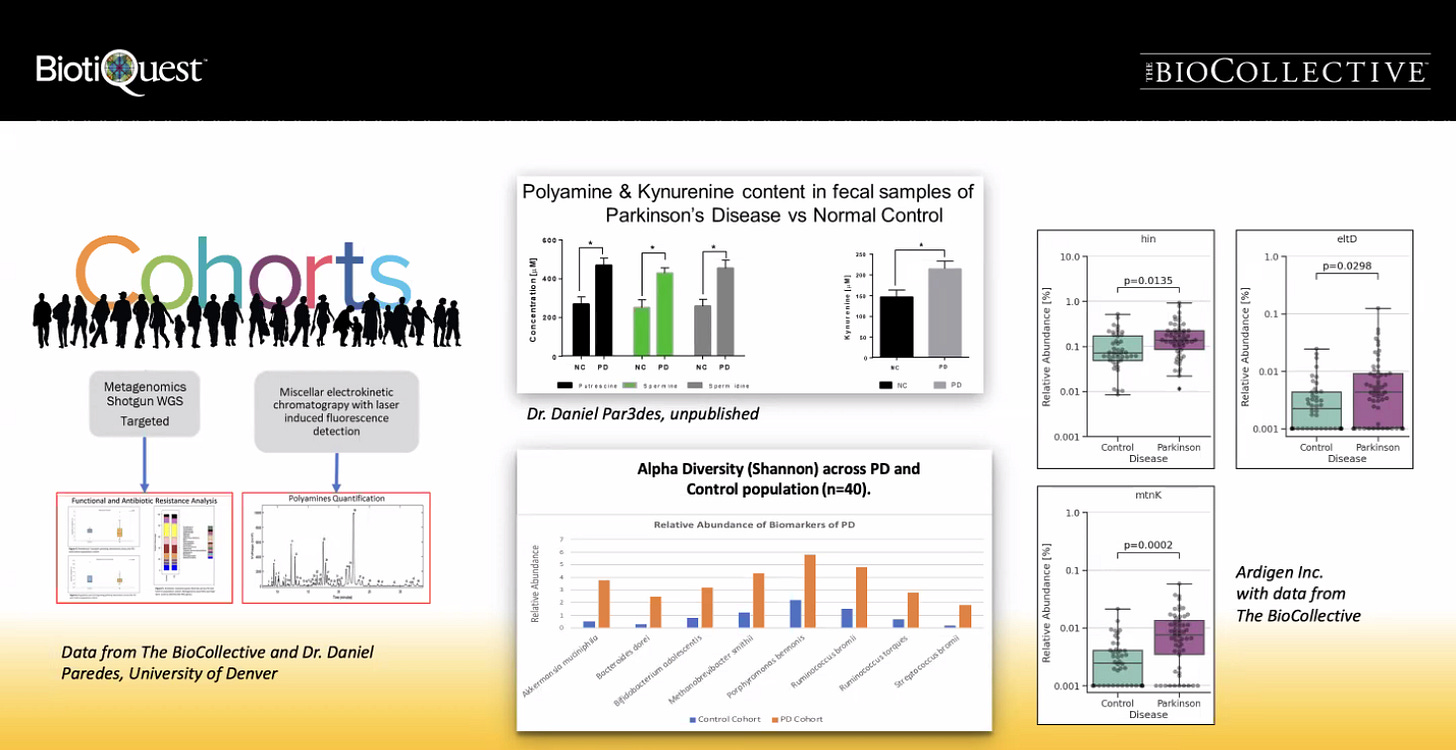Oxidative stress and aging; trace minerals and antioxidants
Mitochondrial DNA changes in Parkinson's Disease and other conditions tends to be found with cellular DNA changes too, underlying causes might include poor methylation cycle function & gut dysbiosis.
For a more detailed review of the current understanding of how oxidative stress and inflammation are involved in the aging process see this chapter from a longer book: Oxidative Stress and the Aging Brain: From Theory to Prevention, [1]
Changes in mitochondrial DNA can lead to reduced energy production and other health problems. Our mitochondria can burn energy for us efficiently, producing a lot more ATP per glucose molecule, or less efficiently, producing less energy and more lactic acid waste. If the mitochondria can’t keep up with antioxidants to reduce the oxidative stress chemicals that are produced as metabolic waste, like the lactic acid, then damage to the mitochondrial DNA may occur and then if the mitochondria divides, there would be two dysfunctional mitochondria in the cell. Some cell types may have 500 mitochondria - so errors would really have to accumulate in many mitochondria before the cell or many cells would be affected. That sort of change is seen in conditions like Parkinson’s disease (PD) which seems to have to do with dysbiosis of the gut microbiome and transfer of inflammatory material from the gut to the brain via the vagal nerves, or it may travel from the brain to the gut too.
For more about Parkinson’s disease, molecular mimicry and the gut microbiome, this live webinar will be available as a recording later. (substack.com) (IPAKedu.org)

Strategies that might help Parkinson’s disease are in the later part of this post:
Elevated polyamines and kynurenine means that digestion of polyamines isn’t happening well and the kynurenine is being made from tryptophan instead of it being made into more helpful serotonin or melatonin. More info about kynurenine is in a presentation linked in this post which has screenshots and discussion of the first part of the presentation. The kynurenine part was later, see the link below:
A slide presentation to read by Tetyana Obukhanych, PhD, Immune Science Educator at BBCH: Gut Feelings - How Our Gut Microbiome and Intestinal Macrophages Impact the Enteric Nervous System (ENS) and Our Well-Being. https://docs.google.com/presentation/d/1a4FJRPjvTR050oKn9kF9F_o0KCZB8neg/mobilepresent (Obukhanych, 2023)
~~
When there is more mitochondrial DNA damage there also tends to be nuclear cell DNA damage too. Functioning methylation cycles are needed for epigenetic control of DNA and other problems can occur in DNA repair or cell division when there is chronic inflammation.
“Mitochondrial DNA has a very high mutation rate; and when a mutation occurs, cells initially contain a combination of wild-type and mutant mtDNAs. During cell division, both types of mtDNA are randomly distributed into the offspring cells. Over many generations, the mtDNA genotype of a cellular lineage can move toward predominantly mutant or wild-type mtDNAs. As the percentage of mutant mtDNA increases, the cellular energy capacity decreases until it falls below the bioenergetic threshold — the minimum energy output necessary for a cell or tissue to function normally. Damage to mtDNA is often accompanied by an increased level of DNA mutations and deletions [25, 26]. Several studies have shown that oxidative-induced mutations in mtDNA accumulate with age in postmitotic tissues such as the brain [27–29]. Several age-related disorders have been shown to be associated with high levels of mtDNA mutations. For example, elevated levels of cortical mtDNA deletions have been found in patients with Alzheimer’s disease [30, 31]. Ikebe et al. [32] found 17 times the level of mtDNA deletion in the striatum of Parkinson’s disease patients when compared with control subjects. Increasing evidence indicates that accumulation of oxidation of DNA, lipid, and protein by free radicals is responsible for the functional decrease in the aged brain.”
Oxidative Stress and the Aging Brain: From Theory to Prevention, [1]
Mitochondria are the main energy producers in cells. They are involved in breaking down each molecule of glucose (one half of the larger molecule that is commonly known as sugar). During the process of breaking the chemical bonds found in the glucose molecule the free radicals that can cause oxidative damage are produced. When adequate antioxidants are available the free radicals are stabilized before they can cause damage. The body's internally produced antioxidant enzymes also require the trace minerals copper, zinc and manganese. /Separate topic: An imbalance in copper and zinc can cause health problems./
"Free radicals are chemical species with a single unpaired electron. The unpaired electron is highly reactive as it seeks to pair with another free electron; this results in the production of another free radical. The newly produced free radical is unstable in most cases and, as a result, it can also react with another molecule to produce yet another free radical. Thus, a chain reaction of free radicals can occur, leading to more and more damaging reactions." [1]
"Several antioxidant defense mechanisms have evolved to protect cell components from the attack of oxidative stress and associated oxidative damage. These mechanisms include antioxidant enzymes, such as SOD, superoxide reductases, catalase, glutathione peroxidases (Gpx), and many heat-shock proteins." "SOD exists in two forms: Cu/ZnSOD is present primarily in the cytoplasm while MnSOD is present primarily in the mitochondria." [1]
More information about manganese superoxide dismutase (MnSOD) and how mitochondria function is available here: MnSOD in Oxidative Stress Response-Potential Regulation via Mitochondrial Protein Influx [2]
Supplementing the diet with a manganese and other trace minerals may be helpful as manganese and other trace minerals may be chelated by glyphosate, the active ingredient of the herbicide RoundUp. Chelation is a chemical term for the tendency for one chemical to bind with another - take hold and make the other one less freely available in the environment. The process can be helpful in some situations as it can act as a carrier, a taxicab so to speak, but at other times it is simply removing the other chemical from being available for other uses.
Plant scientists are aware of the problem and there are agricultural suggestions for reducing the negative effects of manganese chelation by glyphosate in the following article: What About Glyphosate-Induced Manganese Deficiency? The effects of glyphosate's chelation of iron, copper and zinc is also included in addition to the discussion of manganese. [3] The summary of plant yield research found that improved crop yields were produced when manganese, copper and zinc were applied as a supplemental fertilizer a certain amount of time after the glyphosate containing herbicide was applied to the fields:
"The greatest soybean yield response on high organic soils was with both Mn and Cu applied 8 to 12 days after the glyphosate. The highest yields for corn were obtained by foliar-applying Zn 15 days after glyphosate was applied in northwestern Indiana," [3]
So, if plant health scientists recommend supplementing with manganese, copper and zinc for best plant health do human health scientists? Some do, but the topic is still considered alternative medicine rather than being a mainstream medical recommendation. [4] Risks of increased toxicity from trace metals that have negative health effects such as aluminum. [4]
Trace mineral meal planning tips to maximize calcium and magnesium versus phosphorus (we tend to get too much phosphorus and imbalance leads to tooth and bone demineralization) and a downloadable menu example are available in this post:
Meals for trace nutrients - iodine, chromium, zinc and copper.
This is a one week menu prepared by another dietitian which I reviewed and added a few notes and a longer section about the most commonly used seaweed types and their typical iodine content. (pdf in my Dropbox) Adding an extra page with some selenium ideas would help balance the iodine.
Vitamin E food sources
Antioxidant rich foods or supplements that were discussed in the chapter on Oxidative Stress and Aging include vitamin E, which had positive results when used as a supplement in animal studies and mixed results in studies with humans, addition of whole foods such as nuts which are a good source of vitamin E and other nutrients had more consistent positive results in human clinical research studies; Green Tea and its active metabolite EGCG; blueberries, spinach and spirulina, a blue-green algae. [1]
Manganese and other trace minerals can be found in Pure Maple Syrup
Pure maple syrup is an excellent source of manganese - so good that too much regularly could lead to an excess of manganese. It is a trace mineral with a narrow safety range. 1/4 to 1/2 cup of pure maple syrup per day would be a safe limit. An sports rehydration beverage can be made by mixing 1/4 cup of pure maple syrup in 1 liter of water. It was found to be as effective or better for sports rehydration purposes in athletes.

Maple water/pure sap from the tree is very mildly sweet and delicious fresh if you can get some.
Maple syrup as a Substitute for Commercial Sports Drinks: can it be a available Solution for Recreational and Elite Athletes, Jonathan Tremblay, Nicolas Leduc-Savard, Jan. 2019.
Rehydrating efficacy of maple water after exercise-induced dehydration
A maple syrup extract Inhibits the Beta Amyloid and Tau Oligomerization of Alzheimer’s disease, March 2015.
and lots more research on the health benefits of phytonutrients and other aspects found in Pure Maple Syrup - maplescience.org/research.
Disclaimer: Opinions are my own and the information is provided for educational purposes within the guidelines of fair use. While I am a Registered Dietitian this information is not intended to provide individual health guidance. Please see a health professional for individual health care purposes.
Reference List
Carmelina Gemma, Jennifer Vila, Adam Bachstetter, and Paula C. Bickford, Chapter 15: Oxidative Stress and the Aging Brain: From Theory to Prevention, from Brain Aging: Models, Methods, and Mechanisms. Riddle DR, editor. Boca Raton (FL): CRC Press/Taylor & Francis; 2007. https://www.ncbi.nlm.nih.gov/books/NBK3869/
Demet Candas and Jian Jian Li, MnSOD in Oxidative Stress Response-Potential Regulation viaMitochondrial Protein Influx, Antioxid Redox Signal. 2014 Apr 1; 20(10): 1599–1617. https://www.ncbi.nlm.nih.gov/pmc/articles/PMC3942709/
Don M. Huber, What About Glyphosate-Induced Manganese Deficiency?, Fluid Journal, Fall 2007, http://www.agweb.com/assets/import/files/58p20-22.pdf
Anthony Samsel and Stephanie Seneff, Glyphosate, pathways to modern diseases III: Manganese, neurological diseases, and associated pathologies, Surg Neurol Int. 2015; 6: 45. https://www.ncbi.nlm.nih.gov/pmc/articles/PMC4392553/






